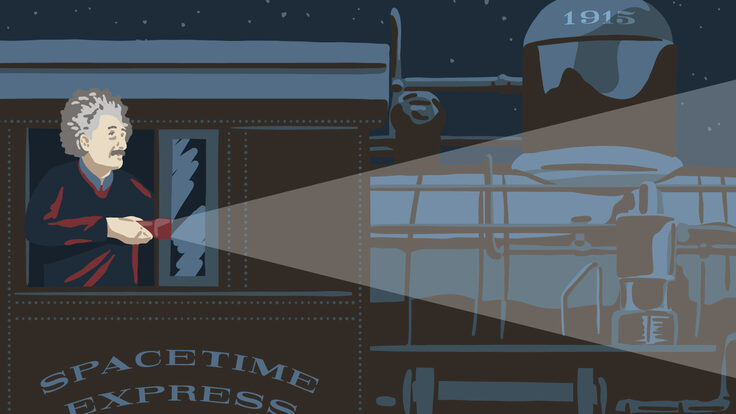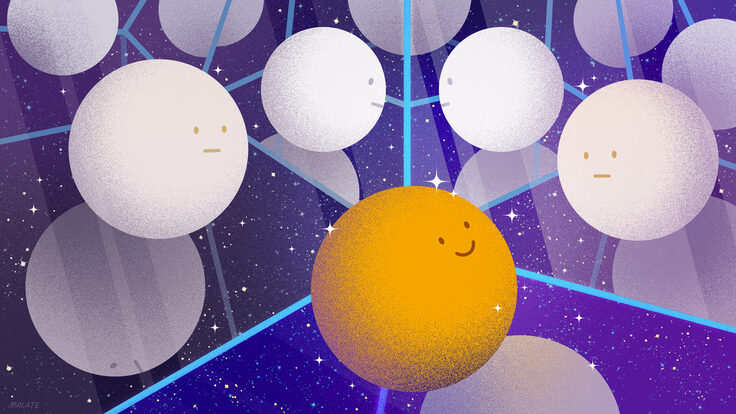It is only the optimists who achieve anything in this world—theorist John Ellis once read this adage on a candy wrapper. It stuck with him, so much so that in 1986 he referenced this candy-wrapper wisdom in his Nature article “The superstring: theory of everything, or of nothing?”
“I was pretty upbeat,” Ellis says. “I was pretty positive about it.”
According to Ellis, ‘theory of everything’ is a rather tongue-in-cheek term for an encompassing framework that links together all physical phenomena on a fundamental level. The idea went viral, both scientifically and culturally. Numerous authors, philosophers and scientific influencers jumped on the bandwagon, including the makers of a 2014 biopic about Stephen Hawking.
So why are so few people talking about a theory of everything today?
“I'd be happy with a theory of anything. Anything more than what is described by the Standard Model.”
“It would be one single engine that drives everything,” says Francesco Sannino, a professor at the University of Southern Denmark. “This is clearly appealing, but also a romantic view of the world around us.”
The too-good Standard Model
Today, Ellis says he is still an optimist, but his expectations are more tempered. “I'd be happy with a theory of anything,” he says. “Anything more than what is described by the Standard Model.”
The Standard Model is the theory physicists have to describe the subatomic world. But the Standard Model is not a theory of everything. It cannot explain the origin of the matter in the universe or its accelerated expansion, nor why galaxies spin as if they contain a huge amount of invisible matter dubbed dark matter. The Standard Model can’t explain gravity, let alone how gravity might be unified with the three other fundamental forces.
But to push beyond the Standard Model and toward a theory of everything, scientists need a foothold in the form of an unexpected deviation—which they have yet to find.
“The Standard Model is too good,” says Peter Woit, a theorist and mathematician at Columbia. “Despite a huge effort we haven’t been able to come up with something better.”
When the Large Hadron Collider started up in 2008, physicists were hopeful they would finally uncover physics beyond the expected. “Several colleagues thought we would see 100 new particles on day one,” Sannino says. “That was naïve and not what nature decided.”
Ellis and many other physicists were hopeful that the LHC would discover supersymmetry, an extension to the Standard Model that solves many problems by adding many new particles. The experimental discovery of supersymmetry would have been a concrete step towards superstring theory, the ‘theory of everything’ Ellis touted in his 1986 article.
“String theory puts everything into one dream theory of everything—you just have to buy seven more dimensions,” Sannino says.
But the LHC found only one new fundamental particle: the Higgs boson, which was the final piece of the Standard Model. All the other discoveries from the LHC have only reinforced the Standard Model’s predictions.
Supersymmetry seemed less and less likely to be right, and superstring theory never materialized into something with testable and concrete predictions.
"The rest of the community is asking, 'Where's the beef?’" Ellis says. “There hasn't been any beef yet. Maybe particle physicists have turned a bit vegetarian and have lost interest in stringy beef.”
Still looking
A sizable fraction of the physics community was once optimistic that they could cultivate string theory into a mathematical tool capable of concrete predictions. “That hasn't happened yet,” Ellis says. “People are now a lot more cautious.”
But all is not lost. String theory has provided new ways of thinking about the relationships between gravity and the other fundamental forces, as well as insights into condensed matter physics and what happens during nuclear collisions inside the LHC.
When heavy ions collide inside the LHC, their internal quarks and gluons melt into a near-perfect fluid. This phenomenon is difficult to explain using traditional approaches. But ideas from string theory show how they can interact with each other in a way that makes a fluid with extremely low viscosity and resistance.
“String theory has morphed into not just a candidate theory of everything—although that still sounds pretty good—but also a theory of some things as well,” Ellis says.
Ellis recognizes that the path toward a theory of everything has turned out to be much more rugged than what he and the scientific community envisioned in the 1980s. “The world is probably much more complicated than we ever could have imagined,” he says.
But he’s still an optimist, and still thinks that physicists should set their sights high. “Newton unified the motion of the apple and the motion of the moon,” Ellis says. “If we set our sights high, we get deep insights.”









